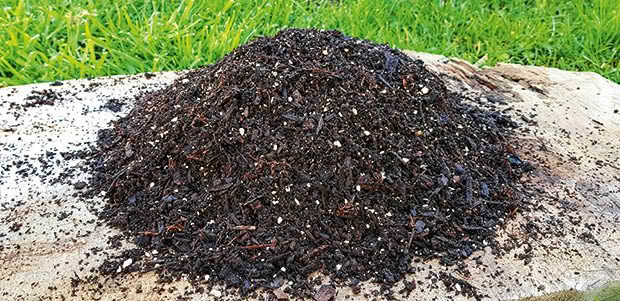How to use autumn leaves to make nutrient-rich leaf mould for the garden

Use autumn leaves to supercharge garden soil.
Words: Kath Irvine
Trees are mineral-gathering machines. Their roots draw calcium, phosphorus, magnesium and potassium from the soil, which is transferred through the trunk to the branches and leaves.
As the leaves change colour and prepare to fall, some of that goodness returns to the tree. The rest remains in the leaf until it touches the ground and is recycled back into the soil via fungi and microbes.
Newly fallen autumn leaves are more mineral-rich than manure and a valuable resource for food gardens. They make nourishing mulch, are useful as the dry component of a compost heap and, with a bit of patience, can be turned into leaf mould. The most minerally rich leaves are the ones that have recently fallen to the ground.
SLOW + FAST
Some leaves break down rapidly, and others take forever. The difference is the amount of lignin in each type of leaf. Lignin is a chemical compound that keeps plants rigid – think of it as an organic form of Polyfilla.

Alder leaf litter.
Leaves with more lignin (oak or birch) don’t compost as effectively as those with less (maple or poplar). Thin, easy-to-crush leaves are generally low in lignin and a good choice for the garden.
WHEN TO LEAVE IT
Fallen fruit and nut-tree leaves are best left in situ. They have a lovely mineral balance, are low in lignin, and break down easily to provide onsite nourishment for the plant next season.

Avoid raking fallen leaves to promote microbial life.
Ornamental trees don’t require as much nutrition as fruit trees. Forage some of the fallen leaves but leave half behind for the tree.
COLLECTION ZONES
Get to know neighbourhood trees and forage for leaves in public parks. There are plenty of owners of large deciduous trees who appreciate someone else collecting them.
SHRED IT
The first step when using leaves to make compost, mulch or leaf mould is to shred the leaves. Run over them with the mower a few times, put them through a shredder, or get a gang of jumping children on the job. Keep shredded leaves somewhere dry and dark until ready to use.
WONDERFUL LEAF MOULD
Leaf mould is that beautiful, soft, dark stuff beneath the twigs and leaves on a forest floor. It is made of broken-down leaf litter and twigs, and it’s teeming with microbes.

Use leaves as mulch.
Leaf mould is the perfect addition to homemade seed-raising mix. It’s a lovely, peaty material that is great for new roots because it warms up well and holds moisture. While it is effortless to put together, it can take up to two years to break down depending on climate and type of leaves.
LEAF MULCH
A mix of shredded leaves makes a beautiful, life-giving mulch for vegetables, herbs, flowers, and berries. Leaves attract microbes and worms in droves, which break down, consume, and incorporate them into the soil humus, helping
a garden thrive.
LIFE BELOW GROUND
The soil beneath plants or mulch is home to millions of subterranean life forms, including beneficial fungi, bacteria, nematodes (roundworms), and worms.
Bare soil is labour-intensive because inevitably, the space will fill up – hello weeds. Weeds are perfect for the job of quickly covering the ground and are part of nature’s cunning plan to keep soil healthy.
Microbes are attracted to plants. In 2018, scientists at Rutgers University discovered that plants “farm” microbes by secreting sugars, proteins, and vitamins around root tips.

Walnut leaves are low in lignin.
Microbes are trapped in the plant cells, then broken down by the plant to become nutrients. Surviving microbes help the plant produce more root hairs. This symbiotic relationship encourages it to grow taller, and roots to grow deeper; more significant root systems provide more opportunities for additional microbes.
The broader the range of plants growing above ground, the more extensive the range of microbes. Microbes improve photosynthesis, convert and distribute minerals, protect plants from pests and disease, build humus and, importantly for the planet, capture carbon. It sounds too simple to be correct, but it is that easy – tap into these powerful networks by keeping soil covered.
HOW TO MAKE LEAF MOULD

• Spread shredded leaves out and lightly moisten.
• Pile them into a simple wire cage or anything with air holes.
• Cover for several months.
• To speed things up, turn the leaves regularly.
HOW TO MAKE HOMEMADE SEED-RAISING MIX

Combine
• 2 parts compost or worm castings or a mix of both
• 2 handfuls river sand or pumice
• 1 part leaf mould
This mixture keeps well if stored in a lidded bucket in a dark, dry place.
This is an extract from our new special edition, Sustainability Through the Seasons, in supermarkets now. This special edition practical guide to living a greener and more environmentally friendly life 365 days of the year. It is packed with self-sufficiency tips on seasonal gardening, low-waste living, garden-to-table cooking, sewing and mending, bread-making and crochet and knitting.


